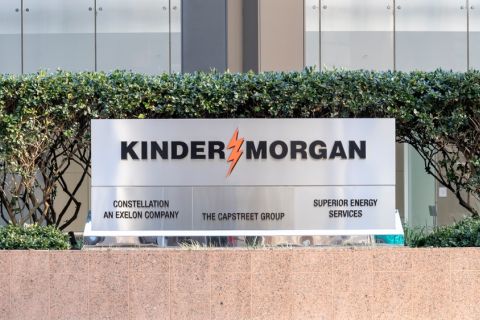Late in October fertilizer producer CF Industries formed a partnership with ExxonMobil to capture and sequester as much as 2 million metric tons of CO₂ starting in 2025 (fishback).
“Exxon has the agreement for transportation and sequestration with CF,” said Scott Goldberg, vice president of EnLink Carbon Solutions, “and we have a transportation service agreement with Exxon to get the CO₂ from CF [at Donaldsonville, Louisiana] to Exxon’s injection facility at Pecan Island [Louisiana].”
While CO₂ midstream takes advantage of assets and expertise that operators already have, “there is no established business model,” Goldberg noted. “The whole oil and gas industry has to rethink the way midstream is approached in many respects.”
EnLink has 4,000 miles of pipe in Louisiana, some of which can easily be converted to CO₂. “Strictly speaking the most efficient way to move CO₂ is in the supercritical, or dense, phase,” said Goldberg. “But we are looking at an entire system and the most effective and economical approach overall is a combination of gas phase and dense phase pipeline transportation.”
For the Exxon-CF project, EnLink has a large-diameter line that runs close to Pecan Island. “It is a legacy line that was built to bring in gas from offshore,” Goldberg explained. “Having 36-inch pipe gets us closer to the dense-phase efficiencies because it is so large, which also saves on capex and opex for high-horsepower compression.”
“CO₂ midstream is, in many ways, just oil and gas midstream in reverse.”—Scott Goldberg, EnLink Carbon Solutions
At the end of that existing pipe, greenfield pipeline will be necessary to reach the sequestration well sites. “Exxon, like all of the sequestration operators to whom we have spoken, wants the CO₂ in dense phase when it hits the wellhead and goes downhole,” Goldberg detailed. “So we will build compression and new pipe for greater than 2,000 psi.”
That flexibility to combine brownfield and greenfield favors larger legacy operators in the nascent field of CO₂ midstream, Goldberg added.
“We have multiple overlapping systems, so can reconfigure one existing line or another for CO₂,” he said.
But there are more benefits to it than that, he added.
“There is also the long-term liability factor,” he continued. “The owners of those molecules, the ones who are getting the tax credits, are also subject to recapture of those credits in the unlikely event that CO₂ escapes from sequestration.
“To be clear, no one expects this to occur, especially when built and managed correctly with the right safety protections and protocols, but the need of these companies to be protected in the subsurface favors working with larger, established firms rather than startups.”
Broadly Goldberg noted that “the physical operations of CO₂ midstream are very similar to those of the hydrocarbon midstream EnLink is already doing. Pressures and flow mechanics are a bit different, but the fundamental assets of pipe, compressors and pumps are the same. At the same time, the business model is all-new, as I said. A molecule of CO₂ on its own does not have value, so it can’t be subject to a sales agreement or put onto the spot market.”
Indeed, the novelty of the business model has given pause to some potential investors in carbon capture, utilization and sequestration (CCUS).
“A business built on tax credits is very different,” Goldberg said, “but companies’ commitments to emissions reductions and the passage of the Inflation Reduction Act gave us and lots of other people enough confidence in the system to build out our business.
“The tax credits may end up being extended after 12 years,” he continued, “but even if that weren’t to happen, most of the capex will have long been in place, so CCS (carbon capture and sequestration) at that point will just be a cost of doing business. Once a big emitter starts capturing, are they going to stop in 12 years and start releasing back to the atmosphere? After their public commitments to reducing emissions? Probably not.”
Circling back to the concept that CO₂ midstream is new thinking for existing assets, Goldberg cited the nature of EnLink’s hydrocarbon business.
“We are building a CO₂ transportation network up and down the Mississippi River” he said. “A lot of our 4,000 miles of pipeline, some of which includes overlapping systems that provide redundancies, is already serving industrial customers with natural gas, so we have relationships with nearly all of the industrial emitters in this area. Some are shippers, some are end-users, some are both at different locations.
“CO₂ midstream is, in many ways, just oil and gas midstream in reverse.”
Recommended Reading
Kissler: Wildcards That Could Impact Oil, Gas Prices in 2025
2024-11-26 - Geopolitics and weather top the list of trends that will determine the direction of oil and gas.
Long-Debated Alaskan NatGas Project Comes Into Focus
2024-11-20 - Pantheon Resources steps up with proposal to bring natural gas to the southern part of the state.
Marcellus Waiting to Exhale But Held Back by Regional, Economic Factors
2024-11-06 - After years of exploitation as one of the country’s first unconventional shale plays, the Marcellus still has plenty of natural gas for producers, even if regional and economic factors have kept much of it bottled up.
Kinder Morgan to Boost NatGas Capacity in Texas
2024-10-16 - Kinder Morgan said it has made FID for the Gulf Coast Express expansion and confirmed a new pipeline project to move gas to the site of future Southeast Texas LNG export facilities.
Mexico Pacific’s Saguaro: LNG’s Quicker Route to Asian Markets
2024-11-19 - Mexico Pacific’s 30-mtpa Saguaro LNG terminal promises a connection to Asia for Permian Gas that avoids the Panama Canal.
Comments
Add new comment
This conversation is moderated according to Hart Energy community rules. Please read the rules before joining the discussion. If you’re experiencing any technical problems, please contact our customer care team.






